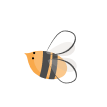- 6 months ago
Fever-Reducing Methods in Children
Should All Fevers Be Treated?
Not necessarily. Fever is a helpful, natural immune response—the body’s way of fighting infection. It’s a symptom, not an illness. Low to moderate fevers (below 38.5°C / 101.3°F) often don’t need to be reduced unless the child is uncomfortable.
However, fever should be treated if:
- The child is clearly unwell or in distress
- Temperature exceeds 38.5°C (101.3°F)
- The child has a history of febrile seizures
- There is reduced fluid intake, lethargy, or irritability
In these cases, fever-reducing strategies can support comfort and safety.
Medication-Based Fever Reduction
Paracetamol (Acetaminophen)
- First-line medication for children
- Safe for use in babies over 3 months
- Dosage: 10–15 mg/kg every 4–6 hours
- Do not exceed 4 doses in 24 hours
Ibuprofen
- Suitable for children over 6 months
- Often used for higher fevers or additional pain (teething, body aches)
- Dosage: 5–10 mg/kg every 6–8 hours
- Should be taken with food or milk to protect the stomach
Aspirin should never be used in children due to the risk of
Reye’s syndrome
Important: Do not alternate paracetamol and ibuprofen unless advised by a doctor. It may confuse dosing and increase the risk of overdose.
Non-Medicated Fever-Reducing Methods
1. Hydration
Children lose fluids faster with fever. Offer fluids frequently—water, breast milk, clear broth, or diluted juice. Dehydration can raise body temperature further.
2. Lukewarm Baths
- Water should be close to body temperature (36–37°C / 96.8–98.6°F)
- Avoid cold water—it can cause shivering, which raises temperature
- Limit to 5–10 minutes, and dry gently afterward
- Bathe only if the child is willing; never force a distressed child into water
3. Light Clothing
Dress the child in light, breathable clothes. Overdressing or covering with heavy blankets traps heat and worsens the fever.
4. Cool Room Temperature
Keep the room around 22–24°C (71–75°F). Air the room regularly. Use a fan indirectly if the room is stuffy—but avoid blowing cold air directly on the child.
5. Avoid Harmful Practices
- Alcohol rubs: Risk of skin absorption and toxicity
- Vinegar compresses: Can irritate the skin or cause chemical burns
- Cold water immersion: May cause chills and vasoconstriction
- Overcooling: May increase internal body temperature in response
When to See a Doctor
Seek medical attention if your child has:
- Fever lasting more than 3 days
- Infants under 6 months with a fever over 38°C
- Trouble breathing, skin color changes, or extreme drowsiness
- Repeated vomiting or refusal to drink fluids
- Fever above 40°C that does not respond to medication
- Seizures, rashes, or signs of dehydration (dry mouth, sunken eyes, no urine)
Fever Management with Dr. Ekin Pasinlioğlu
- Identifying the cause of the fever (viral, bacterial, or other)
- Educating families on safe measurement and home care
- Planning medication doses and timing based on weight and condition
- Offering support for children with a febrile seizure history
- Monitoring children with recurring or difficult-to-manage fevers
- Avoiding unnecessary treatments while ensuring safety








